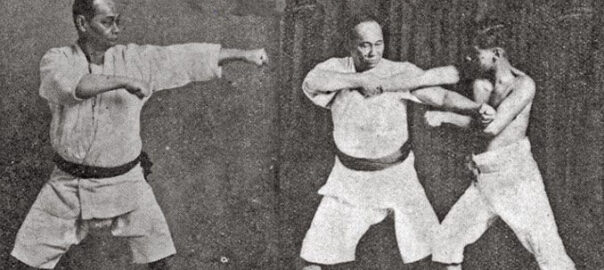Motobu Chōki (1870 – 1944) was an Okinawan karate master and founder of Motobu-Ryu. He was born into a branch of the Ryukyuan royal family, and at the age of 12, he and his older brother Motobu Chōyū invited Ankō Itosu to learn karate. Chōyū was also a noted martial artist.
Motobu also studied karate under Sakuma, Matsumura Sōkon, and Kōsaku Matsumora. He excelled especially in kumite and was already known throughout Okinawa in his twenties. As he grew up, he came to be regarded as the best in Okinawa in terms of practical karate techniques. He is reported to have been very agile, which gained him the nickname Motobu no Saru (“Motobu the Monkey”). He distanced himself from the modernization trend in karate, focusing only on kata Naihanchi and concentrating on kumite practice.
Find more information about the basic kata Naihanchi-Tekki of Motobu-Ryu.
Kamae is in the heart, not a physical manifestation.
Everything is natural, and changing.
One does not have to take care to block every single attack by an oppenent with weak stricking power.
One must develop the ability to deflect an attack even from behind.
In a real confrontation, more than anything else one should strike to the face first, as this is the most effective.
Karate is Sente (Here, sente means the initiative, or the first move; Karate ni Sente Nashi – there is no first move in karate).
The position of the legs and hips in Naifuanchin no Kata (Naihanchi/Tekki) is the basics of karate.
Twisting to the left or right from the Naifuanchin stance will give you the stance used in a real confrontation. Twisting ones way of thinking about Naifuanchin left and right, the various meanings in each movement of the kata will also becom clear.
One must always try and block the attack at its soure (i.e. block not the attacking hand, but deeper on the arm).
The blocking hand must be able to become the attacking hand in an instant. Blocking with one hand then countering with the other is not true bujutsu. Real bujutsu presses forward and blocks and counters in the same motion.
One cannot use continuous attacks against true karate. That is because the blocks of true karate make it impossible for the oppenent to launch a second attack.
I still do not yet know the best way to punch the makiwara (note: this statement was made when Choki was over 60!).
It’s interestin, but when I just think about performing a kata, when I’m seated, I break a sweat.
When punching to the face, one must thrust as if punching through to the back of the head.
When fighting a boxer, it is better to go with his flow, and take up a rhythm with both of your hands.
It is necessary to drink alcohol and pursue other fun human activities. The art (i.e. karate) of someone who is too serious has no “flavor”.
It is OK to take two steps forward or back in the same kamae, but over three steps, one must change the position (facing) of their guard.
When I fought the foreign boxer in Kyoto, he was taller then me so I jumped up and punched him in the face. This is effective against people wo are taller than you.
I started having real fights at TsuJi when I was young, and fought over 100 of them, but I was never hit in the face.
